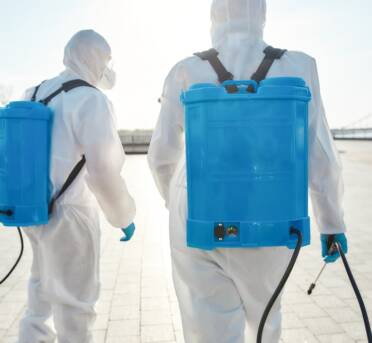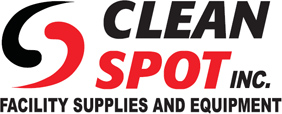
Electrostatic Spraying: How Does It Work?
When it comes to cleaning and disinfecting, we often refer to products and tools that require a little elbow grease – microfibre wipes, spray bottles, and brushes with extendable handles, to name a few. While this is a great first step, it’s incredibly challenging to clean and disinfect hard-to-reach surfaces where germs and bacteria can spread faster than we can clean them.
This is where an electrostatic sprayer is invaluable. Electrostatic spraying can effectively cover a large area quicker, saving time and money for facilities as well as the physical labour for workers.
How electrostatic spraying works
First, it’s important to define what electrostatic spraying is used for. While ‘electrostatic cleaning’ and ‘electrostatic disinfecting’ are used interchangeably, electrostatic spraying systems are specifically designed for disinfection. Electrostatic sprayers do not remove dirt and soil; they are used to disinfect pre-cleaned surfaces.
There are many ways to disinfect a surface, including wipes or dispersing it through fog, mist, or vapour. With an electrostatic sprayer, a small electrical charge is applied to the liquid as it passes through the nozzle. The difference between using fog, mist, or vapour is that the charged droplets stick to the surface easier. Electrostatic disinfection is especially beneficial for the healthcare industry, where disinfection needs to be done quickly, effectively and where some surfaces are hard to reach by hand.
Tips for electrostatic spraying
While electrostatic spraying is safe and effective, caution should always be taken when aerosolizing any disinfectant. Here are our top tips for using an electrostatic sprayer in your facility.
Have a trained professional use the sprayer
These devices are designed to use in professional and commercial settings and should only be used by a trained professional. Be sure to store it in a locked area where only authorized personnel can access it and place signs clearly stating that only trained workers can use the sprayer. When using an electrostatic sprayer, always wear appropriate personal protective equipment (PPE) and follow manufacturer instructions for safety, use, and contact time.
Develop a strategy
Electrostatic disinfecting should only be done in rooms that are not occupied, which requires a schedule and a rotation strategy to keep areas open for business. Depending on the trained staff available and whether you invest in more than one sprayer, this requires some planning and logistics. We recommend conducting a risk assessment of each area and prioritizing rooms at the top of the list. For example, individual patient rooms in a hospital are more of a priority over busy lobbies and waiting rooms.
Create your own protocols and standards
As with any commercial or industrial cleaning product, the use of electrostatic sprayers needs to come with a step-by-step guide and standards for the safety of the user and everyone who uses the facility. We recommend including the following in your protocols:
- Only authorized and trained staff can use the electrostatic sprayer
- Put on the appropriate PPE before spraying
- Gather all supplies beforehand to avoid pausing and restarting the disinfection process
- Only use approved disinfectant products
- Place a sign outside to indicate that disinfecting is in progress
- Start spraying at the far side of the area and work towards the door
- Stick to one spraying strategy: clockwise or counterclockwise, high to low
- Only spray to get the surface wet, not saturated
- Place a sign that the room has been recently disinfected and assign a time when it will be available to use again
- Properly store equipment back in the same place
Where to find an electrostatic sprayer in Calgary
Contact us at Clean Spot to purchase a professional electrostatic sprayer for your facility or to learn more. Clean Spot has been supplying cleaning supplies and equipment for commercial and industrial facilities for over 20 years. We are committed to providing the best customer experience in the industry and making cleaning simple.
Latest Posts
- Earth Day: Keeping a Green Office with Eco-Friendly Janitorial Supplies
- Guide to Commercial Cleaning Supplies and Chemicals for Canadian Businesses
- Streamline Your Cleaning Routine with Janitorial Carts
- Buy, Lease, or Maintain? What’s the Best Option for Your Floor Cleaning Equipment
- Different Garbage Bags for Different Uses
- Preserving Sacred Spaces: Necessary Cleaning Tools and Products for Religious Places
- How a Snowcaster Shovel Can Improve Efficiency on Large Snow Removal Projects
- Xlerator Hand Dryers: The Pros and Cons
- Cleaning Safety: Cleaning Products Not to Mix
- Essential Janitorial Supplies for Movie Theatre Cleaning Services
- Snow Pushers vs. Snow Shovels: Which Tool Is Right for You
- Why Professional Snow Removal Companies Should Invest in Snow Pushers
- 5 Reasons Why Enzymatic Cleaning Chemicals is Essential for Hospitals
- Happy Holidays From Clean Spot
- Ice Melter Buying Guide for Snow & Ice Management Businesses
Browse All Categories
- Bins
- Building Maintenance
- Carts & Trucks
- Cleaning Chemicals
- Cleaning Equipment
- Cleaning Equipment - Parts
- Cleaning Tools & Accessories
- Clearance
- Dust Mopping Supplies
- Floor Pads & Screens
- Garbage Bags
- Hand Dryers
- Hospitality Products
- Ice Melter
- Mats
- MicroFibre Cleaning
- Miscellaneous
- Pandemic Supplies
- Paper And Packaging
- Pure Water Power Window Cleaning
- Vacuum Bags & Common Parts
- Wet Mopping Supplies
- Window Cleaning



